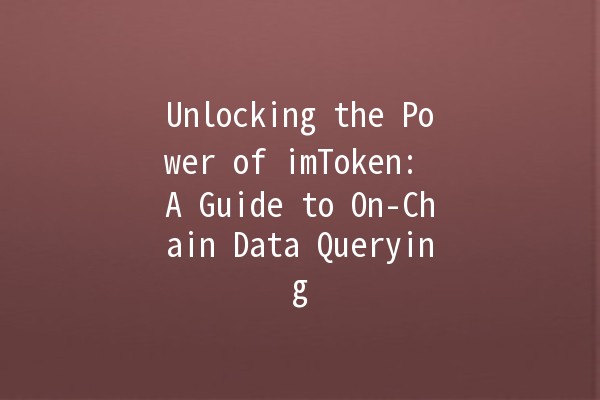In the expanding world of blockchain technology, accessing onchain data is becoming increasingly important for users and developers alike, particularly for platforms such as imToken. This article focuses on how you can effectively perform onchain data queries using imToken, providing practical tips and productivity hacks to enhance your experience and maximize the benefits of the platform.
imToken is a digital wallet designed for users to interact with blockchain networks, particularly Ethereumbased assets. With its userfriendly interface and robust security features, imToken allows users to manage their digital assets seamlessly. One of the standout functionalities of imToken is its capacity for onchain data querying, which provides users with realtime information related to their assets, transactions, and the overall blockchain network.
Onchain data refers to information that is permanently recorded on the blockchain. This includes transaction details, contract information, and user interactions. Accessing this data is crucial for various reasons:

Most modern wallets, including imToken, come equipped with builtin analytics tools that allow users to track their transactions and asset performance over time. Utilize these tools to gain insights into your investments’ performance.
Example: Regularly check your transaction history within imToken to evaluate your trading strategies and identify profitable trends.
For developers and advanced users, integrating APIs can significantly enhance your onchain data querying capabilities. imToken supports various APIs that allow you to programmatically access blockchain data.
Example: If you’re a developer, use imToken’s API to create scripts that automatically pull transaction data for your wallet, allowing you to monitor your assets in real time.
When analyzing onchain data, filtering can save time and provide more relevant insights. imToken offers features to filter transactions based on parameters like date, asset type, and transaction value.
Example: Set up filters to only show transactions above a certain value, helping you focus on highimpact trades.
To stay uptodate with changes in your onchain data, utilizing alert features can keep you informed about important events, such as significant price changes or transaction confirmations.
Example: Use imToken's notification system to set alerts for when a specified asset hits a target price, allowing you to act quickly.
Joining community forums, social media groups, and discussion boards related to imToken can provide you with tips and shared experiences from other users. Engaging with the community can deliver insights and strategies that enhance your onchain data querying efforts.
Example: Participate in discussions on platforms like Reddit or Telegram to learn about hidden features or tools that can improve how you query and analyze onchain data.
To effectively utilize imToken for onchain data querying, familiarize yourself with its interface. Here’s a general outline of how to navigate:
Home Screen: Your wallet’s home screen displays all of your assets, recent transactions, and the option to perform various operations.
Assets Tab: Clicking on this tab allows you to view details about each asset, including transaction history and performance analytics.
Market s: This section provides realtime data about market trends, making it easier to analyze the performance of your assets.
Settings: Adjust notification preferences, security settings, and additional features to tailor the wallet to your needs.
By leveraging the capabilities of imToken for onchain data querying, users can gain valuable insights and tools to enhance their blockchain experience. Implementing the tips outlined above can significantly improve your productivity, allowing you to make informed decisions based on realtime data. Whether you're a casual user or a dedicated developer, mastering onchain data querying is essential for navigating the thriving ecosystem of blockchain technology.
Onchain data refers to the information that is permanently stored on the blockchain. This includes transaction details, user interactions, and smart contract data that provide transparency and security to blockchain operations.
You can access onchain data through the imToken interface by navigating to the assets and transaction sections. The wallet provides builtin analytics and filtering options to help you view the data relevant to your transactions.
While accessing onchain data is generally safe since it is public information, users should be cautious of phishing attempts and ensure that they are using secure networks and devices when interacting with their wallets to protect against unauthorized access.
Yes, imToken provides a comprehensive transaction history that allows users to monitor their past activities, helping to evaluate the performance of their trades and investment strategies.
If you experience issues, check the imToken support center for troubleshooting tips. You can also consult community forums where users often share solutions to common problems.
While there are no strict limits to the amount of onchain data you can access, the usability may depend on the device's performance and the network speed. Efficient filtering techniques can help manage large datasets for easier analysis.
Implementing these strategies will not only empower your data querying but also enhance your overall experience with managing digital assets on the imToken platform.